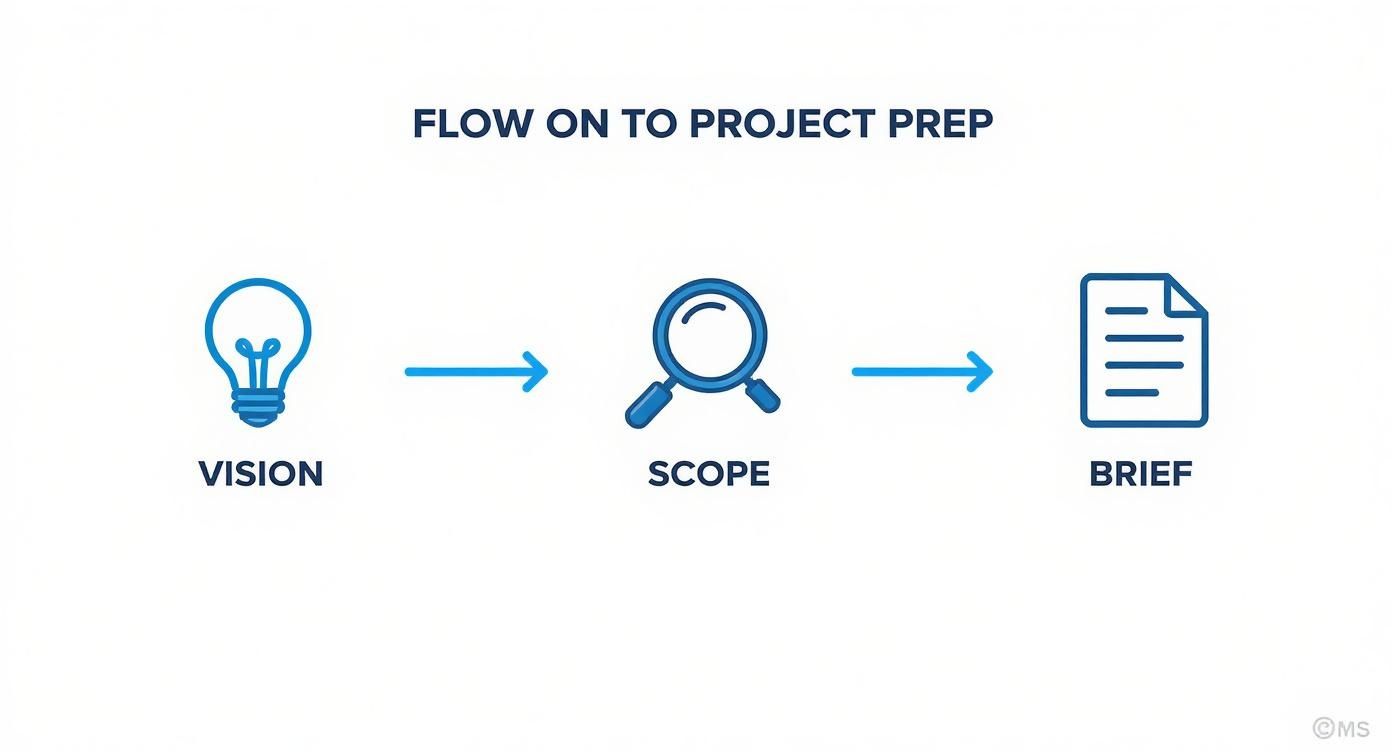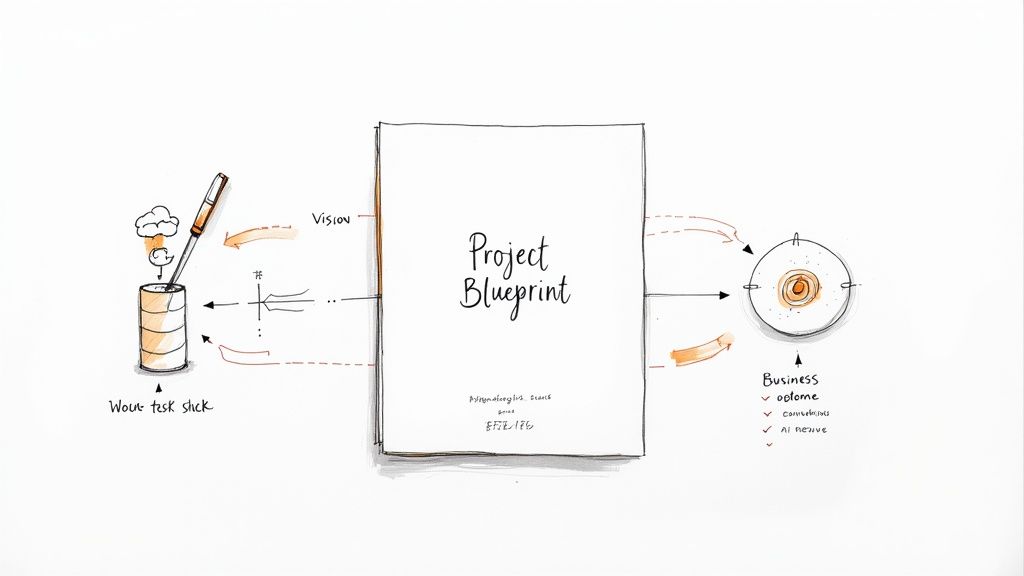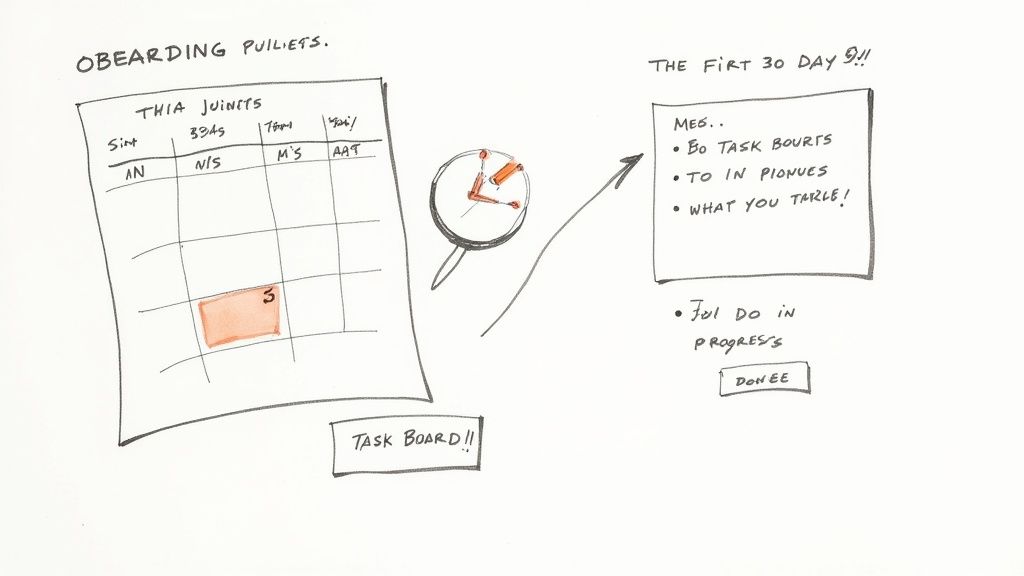- TL;DR: Success in hiring a Python development firm depends on a detailed project brief created before your search begins. Focus your search on a shortlist of 3–5 firms from curated marketplaces and referrals. Vet them with a live architecture session and deep reference checks. Finally, choose an engagement model (T&M for flexibility, Fixed-Price for clear scope) that aligns with your project's needs.
- Who this is for: CTOs, Founders, and Product Leads who need to outsource a Python-based project (e.g., AI/ML features, API development, data engineering) and want a structured process to find, vet, and manage the right development partner. This guide is for leaders who need to act within weeks, not months.
- Actionable Framework: Follow our 4-step process: 1) Define your project with our scoping checklist. 2) Source and shortlist 3-5 firms using our evaluation scorecard. 3) Vet technical skills with a live architecture challenge. 4) Onboard systematically using our 30-day plan.
- Next Step: Use the checklists in this guide to build your project brief and start your search. When you're ready for elite, pre-vetted Python talent, Start a Pilot with us.
Hiring a Python development firm can accelerate your roadmap, but success hinges on one thing: knowing exactly what you need before you start your search.
A fuzzy vision leads to scope creep, blown budgets, and a partner who isn't the right fit. The solution is to translate your business goals into a detailed technical brief. This document acts as a blueprint for any firm you evaluate.
1. Quick Framework: The 4-Step Hiring Process
Walking into a meeting with a potential development partner without a clear project definition is like asking an architect to build a house with no floor plan. You’ll get a dizzying array of quotes and proposed solutions, making it impossible to compare apples to apples.
A well-defined brief is your best defense against miscommunication. It ensures every firm is bidding on the same project so you can evaluate them on a level playing field.

Alt text: A flowchart showing the process of defining a project for a Python development firm, moving from Vision to Scoping to a detailed Brief.
Follow this four-step framework to move from idea to a successful partnership:
- Define: Translate your business vision into a concrete project brief with clear technical requirements.
- Source: Build a shortlist of 3–5 qualified firms using targeted channels and objective criteria.
- Vet: Go beyond portfolios. Assess technical skills with live challenges and conduct deep reference checks.
- Onboard & Manage: Use a structured 30-day onboarding plan and track key performance indicators (KPIs) to ensure alignment and delivery.
2. Practical Examples & Templates
Theory is not enough. Here are two practical examples and a downloadable checklist to help you apply this framework immediately.
Example 1: Project Scoping Scorecard (AI Chatbot)
This scorecard forces internal alignment before you speak to any external firm. It connects business goals directly to technical requirements.
Example 2: Live Architecture Challenge Prompt
To vet a firm's technical thinking, give their lead architect this prompt in a live session.
Prompt: "We need to design a scalable service to ingest real-time product reviews from our e-commerce platform, perform sentiment analysis, and flag negative reviews for immediate follow-up by our support team. The system must handle up to 100 reviews per minute. Whiteboard the high-level architecture on AWS using Python. Focus on cost-efficiency, scalability, and how you would ensure low latency for the sentiment analysis."
What to look for:
- Clarifying Questions: Do they ask about payload size, peak loads, or acceptable latency before drawing?
- Component Choice: Do they justify their choices (e.g., Kinesis vs. SQS for ingestion, Lambda vs. EC2 for processing)?
- Trade-offs: Do they discuss the pros and cons of their approach (e.g., cost of a pre-trained sentiment model vs. a custom one)?
A strong candidate will lead a collaborative discussion, not just present a single "correct" answer.
3. Deep Dive: Vetting and Management
With a clear brief and practical vetting tools, you can now dig deeper into finding and managing the right partner.
Sourcing and Shortlisting Potential Partners
The global software development market was valued at $203.35 billion in 2022 and is projected to reach $1,450.87 billion by 2031. A huge portion is fueled by AI and automation, Python's home turf. Giants like Facebook built 21% of their codebase in Python for its power and scalability. As the market grows, so does the number of specialized firms. You can learn more about this trend on netguru.com.
Start your search with channels that provide some level of pre-vetting.

Alt text: A team of professionals shortlisting Python development firms on a digital platform, representing the vetting process.
- Curated Marketplaces (Clutch, GoodFirms): These platforms offer verified client reviews, which provide an unfiltered look at a firm's project management and communication skills.
- Professional Networks (LinkedIn): A recommendation from a trusted colleague who has worked with a firm is invaluable. It gives you an honest perspective you won't find in a case study.
Use this simple scorecard to quickly screen potential partners and build your shortlist of 3–5 contenders.
Choosing The Right Engagement And Pricing Model
The engagement model is the foundation of your partnership. It dictates budget, scope management, and goal alignment.

Alt text: A team at a Python development firm discusses engagement models like Time & Materials vs. Fixed Price with a client.
Specialized firms like Mangosoft and ScienceSoft have extensive experience structuring deals for projects of all sizes. You can find more examples of leading Python development companies on algoscale.com.
Rates vary by region and experience. For a deeper analysis, see our guide on IT outsourcing for development.
Onboarding and Managing Your New Partner
The first 30 days set the tone for the entire engagement. A structured onboarding process builds momentum and ensures your new partner adds value immediately.
Here’s a practical framework:
- Week 1: Systems & Access. Grant access to your core systems: Slack, Jira, code repositories, and development environments. Don't make them wait.
- Week 2: Knowledge Transfer. Conduct deep-dive sessions on business goals, user personas, and existing architecture. Pair their lead engineer with one of yours.
- Weeks 3-4: First Sprint & Calibration. Assign a small but meaningful task. The goal is to road-test the collaborative process and calibrate communication styles. This is critical for understanding project manager costs and responsibilities.
Track these Key Performance Indicators (KPIs) to measure success objectively.
The first 90 days are a probationary period. Address red flags—like inconsistent communication or consistently missed milestones—immediately to ensure long-term IT project success.
4. Checklist: Are You Ready to Hire?
Before you contact your first Python development firm, ensure you have clear answers to these questions. This checklist summarizes the critical steps from this guide.
Project Definition Checklist:
- Business Goal: Have you defined a primary success metric (e.g., reduce churn by 15%)?
- Core Functionality: Have you listed the must-have features for an MVP?
- Technical Requirements: Have you specified your preferred frameworks (Flask), databases (PostgreSQL, MongoDB), and infrastructure?
- Integrations: Have you listed all required third-party services?
- Budget & Timeline: Do you have a realistic budget and target launch date?
Partner Vetting Checklist:
- Shortlist: Have you identified 3–5 firms with relevant domain experience?
- Technical Vetting: Have you prepared a live architecture challenge?
- Process Vetting: Do you have specific questions about their agile methodology and QA process?
- Reference Checks: Have you prepared outcome-focused questions for their past clients?
- Contract: Does the agreement clearly state you own 100% of the intellectual property?
5. What to Do Next

Alt text: A founder considers common questions about hiring a Python development firm, such as intellectual property and security.
- Complete the Checklist. Use the checklist above to create your detailed project brief. This is the single most important step.
- Build Your Shortlist. Identify 3-5 potential firms from Clutch, GoodFirms, or professional referrals that align with your technical and industry needs.
- Schedule Scoping Calls. Reach out to your shortlisted firms with your project brief and schedule initial 30-minute discovery calls to begin the vetting process.
Ready to build your AI team with vetted, senior Python talent? ThirstySprout helps you hire top-tier AI and software engineers who integrate seamlessly with your team and ship quality software fast. Start a Pilot.
6. References
Hire from the Top 1% Talent Network
Ready to accelerate your hiring or scale your company with our top-tier technical talent? Let's chat.

